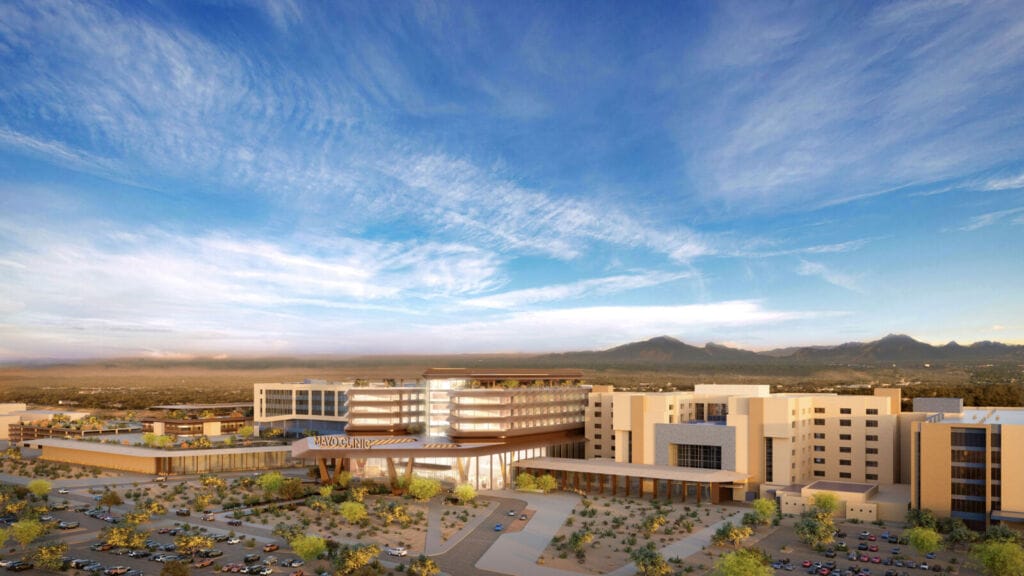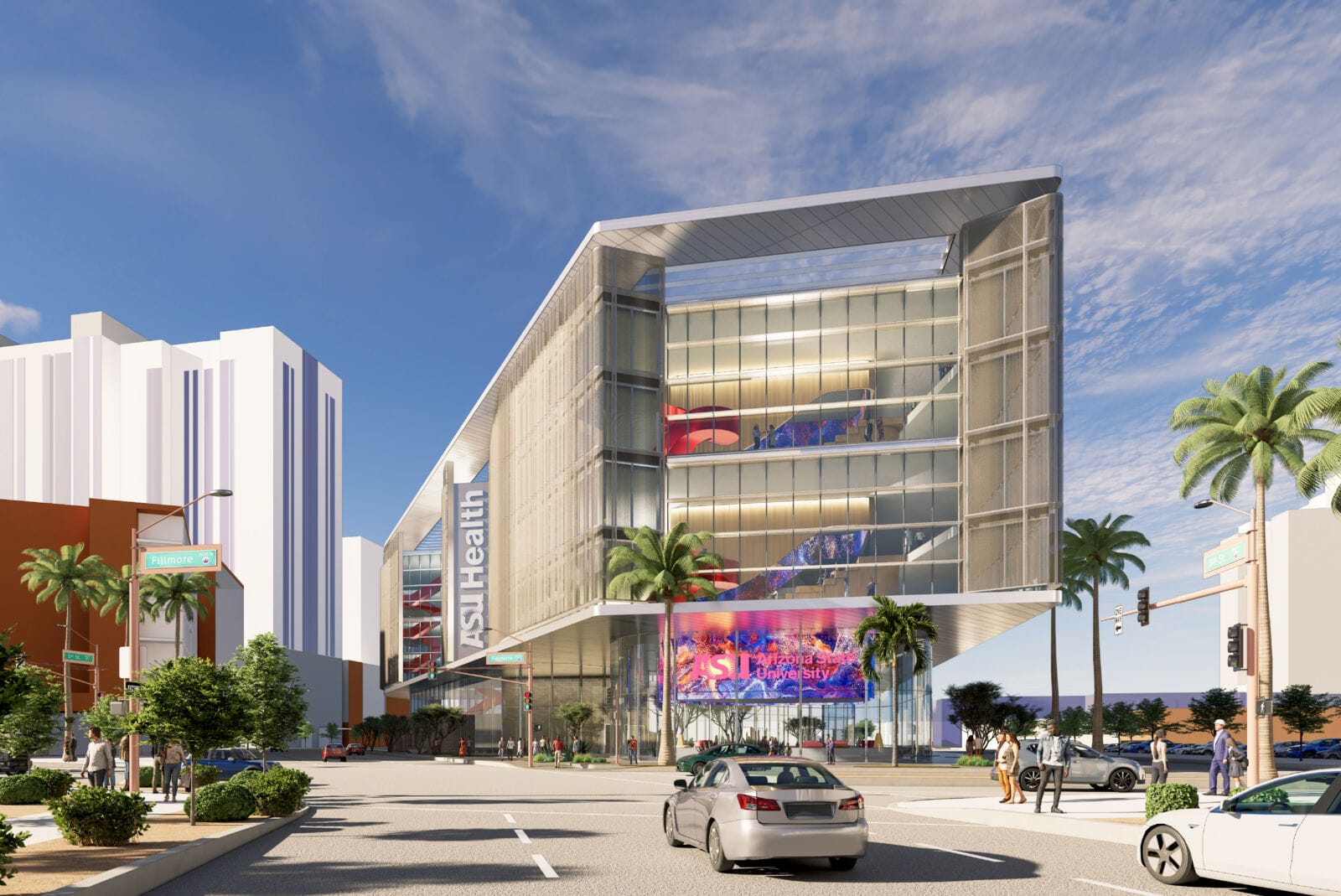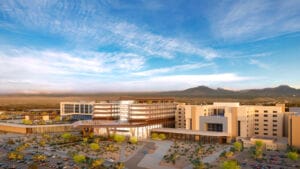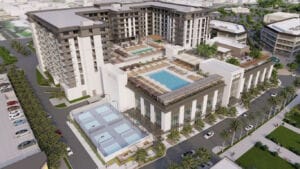Healthcare facilities drive development in cities in numerous ways. Hospitals and health campuses need construction crews to build the campus, creating jobs in that sector. Once construction is complete, hospital staffing needs continue to increase employment as well. Beyond creating a powerful economic engine, these centers of healing provide hope to people when they need it most.
While the entire Valley is seeing a surge of medical infrastructure, the recently announced ASU Health Headquarters in Downtown Phoenix and the $1.9 billion investment by Mayo Clinic will have a long-lasting impact on healthcare outcomes. Communities in Greater Phoenix and beyond will see increased access to care as new campuses are built and existing ones are expanded.
Bold. Forward. Unbound.
On March 3, Mayo Clinic announced that it’s committing just short of $2 billion in its Phoenix campus. The multi-billion-dollar investment will include a 1.2-million-square-foot expansion, bringing the campus to almost 4 million square feet with the ability to expand to 8 million in the future.
As part of its “Bold. Forward. Unbound.” strategy, the project includes a new procedural building and a five-floor expansion of the clinic’s specialty building. Eleven new operating rooms and two new patient support units supporting 48 additional beds will be added as well. There will also be a two-story indoor promenade to connect buildings around the campus so that visitors and patients may move more efficiently from building to building.
Dr. Mitchell Humphreys, chairperson of Bold. Forward. Unbound in Arizona notes that one of the essential concepts for this project is care neighborhoods. Patients shouldn’t have to move around all over the campus to reach other specialties but instead be located near all relevant specialties.
Another big part of the project is the patient experience. Humphreys adds that Mayo Clinic has spent time visiting Disney and looking at Google to observe their curation processes and amenities.
“We’re not just thinking about healthcare. We’re talking about having patient input on how to design some of these amenities and common ground space,” Humphreys continues.
Improved and updated technology will be another focal point of the expansion.
“Certainly, part of this project is automation and digital and robotics, but at its heart, it’s about people taking care of people and using technologies to enhance what we do,” Humphreys says.
DEEPER DIVE: Here’s how AI is fueling innovation and efficiency in healthcare
INDUSTRY INSIGHTS: Want more news like this? Get our free newsletter here
Not only will the project provide increased healthcare access to nearby populations but it will also boost the Phoenix economy. Humphreys highlights that while the seven-year project will generate construction and architectural spending, the bigger impact is with medical staffing. Nurses, doctors, imaging technicians and more will be needed to fulfill the vision of Bold. Forward. Unbound.
“All the things that go along with the spaces we’re constructing and the way we deliver next-level care will be a huge job opportunity and economically impact the area around us,” Humphreys says.

ASU Health
On March 10, ASU announced the location for its ASU Health headquarters, which includes its new medical school. Situated in the heart of Downtown Phoenix between Fillmore and Fifth Street, the new hub is only a few blocks away from ASU’s Downtown Phoenix campus. The location was carefully selected so it could be part of the Phoenix Bioscience Core innovation zone, which hosts federal, corporate, start-up and educational medical science leaders.
“It was an obvious choice from our perspective,” says Rick Naimark, ASU’s associate vice president of program development planning.
The project was a result of the Arizona Board of Regents’ AZ Healthy Tomorrow initiative. The plan asked all three major Arizona universities to develop ways to build the state’s healthcare workforce.
“Every single health profession is facing severe shortages in Arizona. The number of doctors and nurses per population is extremely low per state,” Naimark says. “By building the ASU health programs, the school will dramatically increase the number of health professionals to serve the growing Arizona population.”
The project will also partner with other ASU colleges. The W.P. Carey School of Business will work on supply chain issues and the Walter Cronkite School of Journalism and Mass Communication will share health concerns with the public through patient interviews.
Sherine Gabriel, executive vice president of ASU Health, says ASU is leveraging talent, experience and infrastructure across the university to differentiate the medical school.
“Everything about the medical school is innovative. It’s not just a medical school, it’s a school of medicine and advanced medical engineering,” Gabriel says. “It’s a very unusual, atypical, innovative curriculum you won’t see anywhere else.”
The site is expected to be completed and open in time for the Fall 2028 semester. Over the next 10 years, the project is expected to add $19 billion to the state’s GDP and bring in 200,000 jobs.




